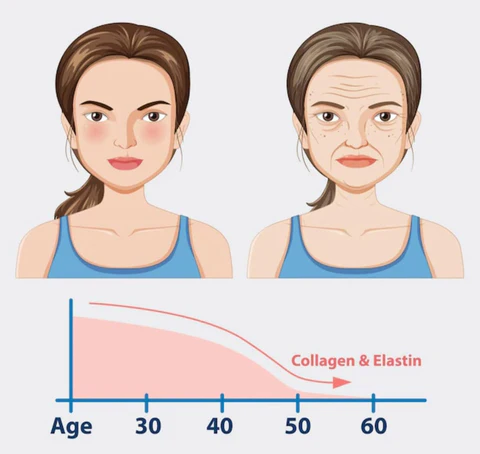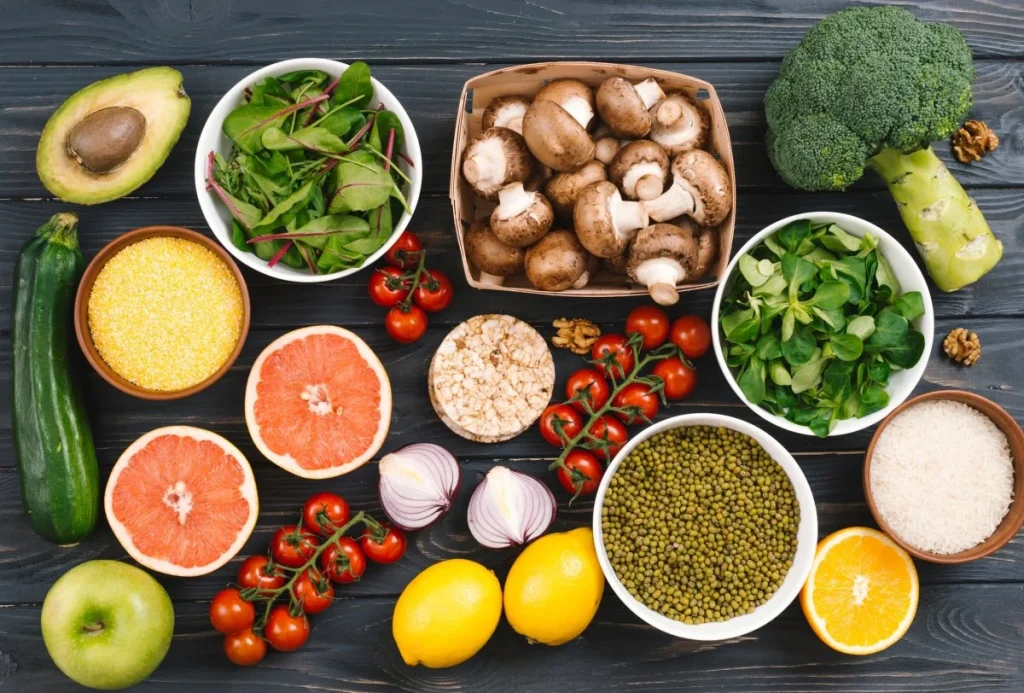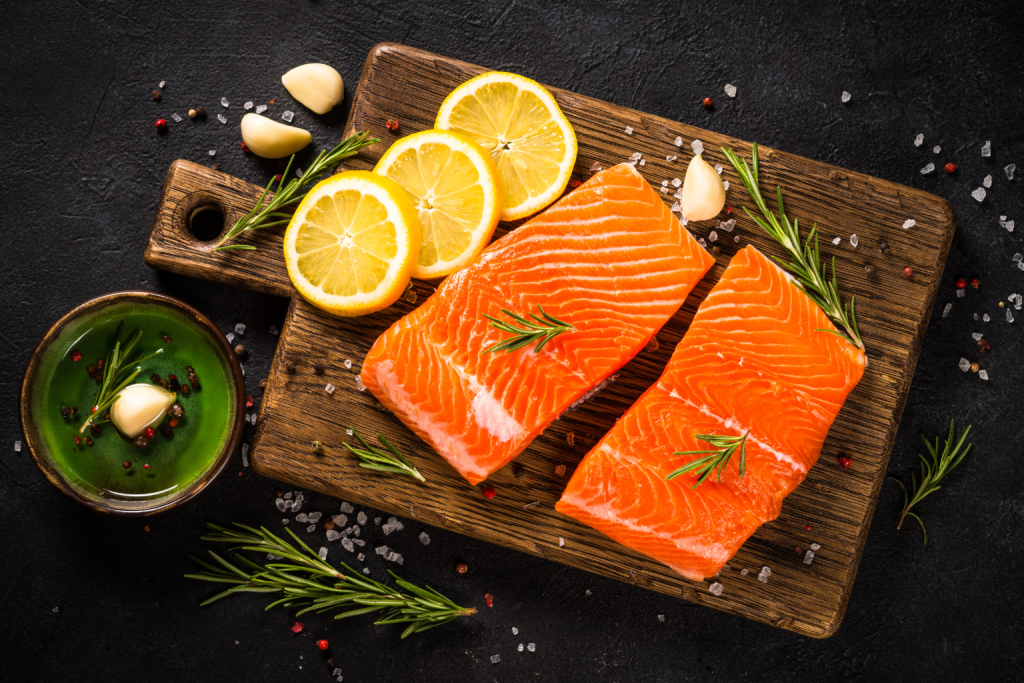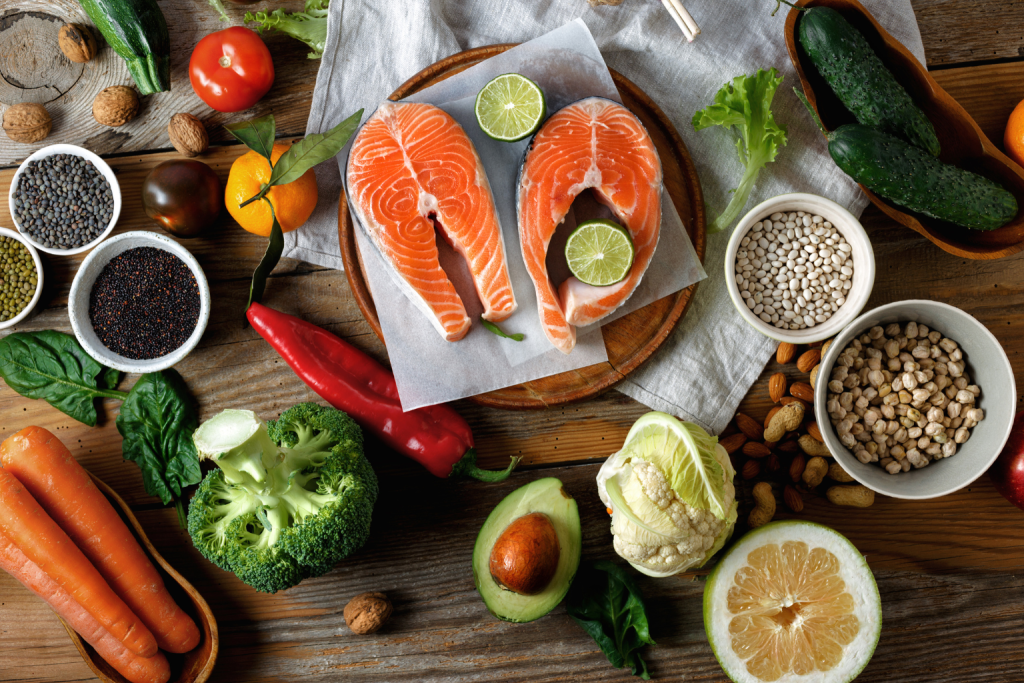Introduction: The Science Behind Elastin & Collagen for Skin Health
Let’s not sugarcoat this: Most people lose about 1% of their collagen each year after age 20. Elastin and collagen rich foods significantly affect how your skin ages. According to a 2023 meta-analysis of 26 randomized controlled trials, regular intake of specific nutrients can enhance skin elasticity by up to 12 percent—5% in just 8 weeks. But behind closed doors, dermatologists often discuss another strategy for patients to implement at home: diet. Viewed over time, it becomes impossible to separate the true impact of these dietary shifts without referencing what foods are good for aging skin as explained in recent 2025 nutritional research, which exposes subtle connections most people overlook.
Elastin and Collagen: Why Both Matter for Healthy Skin
Understand the untold story about elastin and collagen rich foods by learning how each protein works. While most skincare discussions focus solely on collagen, elastin deserves equal attention, especially when considering the body’s own ability to produce more collagen with targeted nutritional strategies, which is a factor in long-term skin resilience.
Collagen is the most prevalent protein in the body, constituting approximately 75–80% of the dry weight of human skin. The tightly packed arrangement forms a thick network of fibers, which ensures the structure and firmness of the dermal layer. Think of collagen as the foundation beneath your skin, providing it with thickness and support to prevent sagging. Yet, the process by which these fibers degrade in response to chronically high glucose is rarely acknowledged, leading to an incomplete picture of the connection between sugar, carbs, and skin aging through their role in wrinkles and collagen breakdown.
What is elastin? As its name implies, elastin provides structural support to the skin by giving it the ability to stretch and “bounce back” after stretching. When the skin is unable to produce adequate amounts of elastin, it cannot easily return to its original form after stretching. A study published in 2024 in Frontiers in Nutrition found that both proteins deteriorate similarly via oxidative stress and inflammation but at different rates. Collagen breaks down more quickly, while elastin loss is slower but much harder to reverse. Industry insiders warn that by the age of 50, most women have lost almost half of their skin’s collagen and elastin production has nearly ceased.
Thus, anti-aging approaches should target the two proteins. And the big mistake people make is to focus on collagen supplementation while ignoring dietary strategies that support both proteins. The meta-analysis (1721 participants) showed that constant consumption of the studied nutrients significantly improved skin elasticity (Z=4.49, p<0.00001) and hydration (Z=4.94, p<0.00001). Yet many miss that specific foods have unique properties for increasing overall skin elasticity in 2025 and beyond, demanding more nuanced diet choices.

| Protein | Main Function | Age-Related Breakdown |
|---|---|---|
| Collagen | Firmness, support, structure | Faster; significant loss by age 50 |
| Elastin | Elasticity, ability to “bounce back” | Slower; but recovery is much harder |
The Complete List: Top Elastin and Collagen Rich Foods
Meat-Based Collagen and Elastin Boosters

Let’s call it what it is: animal products are the most direct sources of elastin and collagen rich foods available. While plant foods help the body synthesize these proteins, animal tissues have them in forms that are easily accessed and stored by the body. Many traditional diets emphasized these foods long before laboratory analyses confirmed their impact on younger looking skin through 2025’s best food choices, highlighting practices rooted in efficacy rather than trend.
- Bone broth: The undisputed king, with 8–12g of collagen per 100ml. The collagen molecules, thanks to the way the soup is prepared (simmering for 12–24 hours at low temperatures of 160–180°F), retain their triple helix structure (the so-called native collagen) and thus are more bioavailable. High-heat cooking, in turn, denatures the proteins to the point that they lose this capability. This preparation method bridges culinary tradition and modern science for functional skin nutrition.
- Chicken skin: 5–7 g per 100 g. Time to be honest, most people throw away chicken skin, but studies indicate that some of the most bioavailable collagen is found there. The accountability gap in the advice given has led many people to discard this otherwise valuable source of health information. Emerging insight into foods capable of reducing under eye wrinkles using targeted proteins further explains why every element of the chicken deserves scrutiny.
- Fish skin (wild-caught salmon): 2–3 g (per 100 g) in addition to the omega-3 fatty acids. Behind closed doors, dermatologists highly recommend salmon skin because it is rich in collagen and anti-inflammatory.
No one is talking about this—plant foods do not contain collagen and elastin; rather, they help your body obtain all of the nutrients required to make these proteins on its own.
Plant-Based Collagen and Elastin Supporters

These anti ageing superfoods work in a unique way compared to animal-derived products by promoting your body’s own production. Understanding how to optimize this effect is at the heart of choosing collagen rich vegetarian foods for a youthful skin outcome, which can yield results on par with animal sources when used thoughtfully.
- Citrus fruits stand at the pinnacle of the foods that boost collagen and elastin since they are an exceptionally rich source of vitamin C (40–60mg per 100g). Vitamin C is essential for the hydroxylation of proline and lysine, two amino acids needed to form the triple helix structure of collagen. Hard questions need asking: why do so many collagen supplements lack vitamin C when research shows it increases collagen synthesis by 30–50%?
- Berries (especially blueberries, blackberries and cranberries) contain proanthocyanidins that inhibit the MAPK pathway—one of the major causes of collagen and elastin degradation. A 2025 study reported that they increase TIMP-1 levels, preventing the breakdown of existing collagen and elastin fibers. The power of certain foods to reduce wrinkles on the face emerged from these polyphenol-rich sources, shifting modern best practices in dermatological nutrition.
- Soy products provide 5–1g of plant collagen due to the isoflavones content. Isoflavones stimulate collagen synthesis via estrogen receptors. For those seeking collagen rich food vegetarian options, soy represents one of the most effective alternatives to animal sources.
- Leafy greens (e.g., spinach, kale) provide copper and vitamin K, which are necessary for lysyl oxidase enzyme activity that ensures proper collagen and elastin cross-linking. Industry experts note that these nutrients are sometimes overlooked but crucial for the structural integrity of body proteins. Only recently has the evidence for identifying foods that accelerate skin elasticity gains included specific doses and combinations, reflecting advances since the turn of the decade.
- Pumpkin seeds are exceptionally rich in copper (8–10 mg per 100 g), which is needed for the enzyme lysyl oxidase and elastin fiber formation.
Serving Ideas: Make a smoothie with citrus juice, berries, and soy yogurt. Toss leafy greens with pumpkin seeds and a citrus vinaigrette. Add berries to dark chocolate for an anti ageing superfoods treat. If you want to see these meals come to life, experiment with collagen rich recipes designed to deliver a youthful skin glow, applying the theory as everyday practice.
Seafoods and Eggs

- Shellfish, especially oysters, are rich in copper (1–2 mg per 100 g), which is essential for collagen synthesis because it acts as a cofactor for the enzyme lysyl oxidase. And no matter how much you eat, those proteins will not work as they should if the bonds are deficient.
- Oily fish such as salmon, mackerel and sardines are rich in omega-3 fatty acids, which help reduce inflammation and protect existing collagen in the body. The imbalance of power in nutrition advice means that we only value protein content and ignore other aspects. Ultimately, a full appreciation of fatty fish’s omega-3 benefits for youthful skin bridges the gap between culinary preference and practical anti-aging outcomes.
- Egg whites contain proline and glycine (the amino acids that form collagen) and egg yolks are a source of choline. Choline helps maintain the structure of cell membranes, including those of fibroblasts, which are responsible for producing collagen and elastin in the body.
Comparison Table: Top Elastin and Collagen-Rich Foods
| Food | Collagen (g/100g) | Elastin Support | Vitamin C (mg) | Copper (mg) | Key Benefit |
|---|---|---|---|---|---|
| Bone Broth | 8-12 | Low | 0 | 0 | Direct collagen source, joint health |
| Chicken Skin | 5-7 | Moderate | 0 | 0.05 | Hyaluronic acid precursors, omega-3s |
| Citrus Fruits | 0 | High | 40-60 | 0 | Essential for collagen synthesis |
| Berries | 0 | High | 20-80 | 0.1 | Prevent collagen/elastin degradation, activate collagen pathways |
| Pumpkin Seeds | 0 | Very High | 1.0 | 8-10 | Elastin formation, highest bioavailable copper source |
| Soybeans | 5-10 | High | 6.0 | 0.38 | Collagen synthesis via isoflavones |
| Oily Fish | 2–3 | Moderate | 0 | 0.1 | Omega-3s protect collagen/elastin |
| Egg Whites | 0 | Support via amino acids | 0 | 0.02 | Provides proline, glycine |
| Oysters | 0 | Very High | 0 | 1-2 | Copper for collagen and elastin synthesis |
(Data from recent scientific sources)
Food Combinations & Absorption Tips: Maximize Your Results
The most powerful combination is to consume collagen rich foods and vitamin C sources together. A 2023 study found that vitamin C consumption increases collagen synthesis by 30–50% (see meta-analysis). But the synergy between these foods goes beyond isolated nutrients; it is the intersection that creates the optimal environment for maximizing the body’s capability to increase skin elasticity through food-based strategies.
- Bone broth (lemon juice)
- Chicken (bell peppers)
- Fish (citrus marinade)
For foods that boost collagen and elastin synthesis in the body, they need vitamin C for copper absorption. Oysters and lemon have the highest bioavailability. Other pairings include:
- Pumpkin seeds (citrus salad dressing)
- Dark chocolate (berries, proanthocyanidins + copper = collagen/elastin boost)
One study found that 8 weeks of consistent product consumption is required for a significant improvement in skin elasticity (meta-analysis source). We need to act now because short-term strategies do not work. Equally relevant is appreciating the continuous role of foods in supporting younger-looking skin—far beyond rapid fixes.
Anti-inflammatory foods should also be part of any strategy to stop collagen loss because inflammation is the main factor in protein degradation. Turmeric, ginger and olive oil reduce MMPs (matrix metalloproteinases) which are enzymes that break down collagen and elastin. The impact of these dietary shifts often reaches its full potential only when combined with a clear, evidence-based guide to choosing foods suitable for aging skin in 2025 and beyond.

Meal Planning Strategies: Daily Diet Integration
Here’s a sample menu plan for both omnivores and vegetarians to help you get elastin and collagen rich foods every day. What’s often ignored is just how much habit formation can be shaped by accessible collagen rich recipes specifically designed to maintain a skin youthful glow, where meal structure supports nutrient synergy at every step.
Breakfast Options:
- Omnivore: Bone broth smoothie with berries and citrus, collagen powder.
- Vegetarian: Soy yogurt with berries, pumpkin seeds, vitamin C-rich fruits.
Lunch Ideas:
- Omnivore: Salmon salad with leafy greens, citrus dressing, and pumpkin seeds.
- Vegetarian: Lentil soup with tomatoes, bell peppers, dark leafy greens.
Dinner Suggestions:
- Omnivore: Slow-cooked chicken with skin in turmeric and citrus glaze.
- Vegetarian: Tofu stir-fry with broccoli and bell peppers, sesame seeds.
Strategic Snacks:
- Homemade bone broth gummies with citrus (omnivore)
- Dark chocolate with berries (both)
- Hummus with bell pepper slices (vegetarian)
Industry experts note that people tend to quit before the minimum 8-week product commitment due to a lack of patience. Adhering to regular eating patterns formed around foods scientifically shown to reduce facial wrinkles during this window often separates visible transformation from minimal results.
Q&A: Collagen & Elastin Diet Myths, FAQs & Research-Backed Answers
Q: Can a plant-based diet adequately promote collagen and elastin?
Yes, plant-based protein sources can be complete, although not all of them are. While elastin and collagen-rich animal foods provide the proteins directly, plant foods support your body’s synthesis pathways. The 2025 study published in Frontiers in Nutrition also found that proanthocyanidins from plant sources could activate the TGF-β/Smad pathway and inhibit MAPK degradation, which promotes collagen and elastin synthesis similarly to animal-derived proanthocyanidins. By analyzing collagen rich vegetarian food strategies for a more youthful skin appearance, it becomes clear how food selection can compensate for absence of animal products.
Q: Are collagen supplements better than foods?
Not necessarily. While supplements provide a concentrated dose, the best collagen sources for boosting offer synergistic nutrients that naturally enhance collagen formation and use. Harvard Medical School notes that whole food sources naturally combine collagen with other nutrients like vitamin C, copper, and zinc, which are essential for collagen synthesis. In addition, the founder’s myth that supplements are naturally better has not been proven. In practical terms, the pattern of utilizing foods to reduce visible facial wrinkles highlights the role of synergy absent in many supplement regimens.
Q: How long before I see results from dietary changes?
A meta-analysis of 26 randomized controlled trials on 1,721 patients indicated that the consistent use of collagen supplements for at least 8 weeks is required to obtain measurable improvements in skin elasticity and hydration. The Silicon Valley expectation of immediate results is reinforced by the fact that innovation is happening on multiple, fast-moving fronts. (Read the 2023 meta-analysis). To truly capitalize on this momentum, it’s essential that meal planning incorporates collagen rich recipes that amplify youthful glow results with consistency rather than isolated efforts.
Q: Can the collagen we ingest truly reach and replenish the skin?
Yes. Contrary to popular belief, the body actually breaks down dietary collagen into peptides and amino acids that can be reassembled into new collagen in the skin. A 2023 meta-analysis demonstrated that hydrolyzed collagen significantly improved skin hydration (Z=4.94, p<0.00001) and elasticity (Z=4.49, p<0.00001), confirming its absorption and utilization in the body. Those seeking a methodical route can rely on the advanced breakdown of how the body is able to produce more collagen from dietary intake and strategically select foods as rebuilders.
Q: What is the minimum amount of collagen to take daily for skin benefits?
5–10g of collagen daily (or an equivalent amount from food) for 8 weeks or longer significantly improves skin health (see Healthline collagen guide). For the body to generate collagen, it is necessary to consistently consume vitamin C (75–90 mg per day) and copper (1–2 mg per day). For a full strategy, choosing the best foods that reduce stubborn under eye wrinkles can dramatically optimize your results when done in parallel.
While deeper strategies are explored throughout this guide, every perspective ultimately points toward the most effective foods for youthful and resilient skin now and in 2025, establishing a foundation backed by evolving science.
The accountability gap for skincare has been too narrow as it ignored the basal level principle of nature’s law. This comprehensive guide to elastin and collagen rich foods will help you implement an evidence-based approach to skin health. However, to truly activate the skin’s regenerative potential, focus not just on isolated nutrients but on the most impactful foods for increasing skin elasticity and integrating them within daily routines for the deepest, most sustained benefits.
References
- 2023 Meta-Analysis: Collagen and Elastin Intake Effects (PMC)
- 2025 Plant-Based Collagen/Elastin Synthesis Study (Frontiers in Nutrition)
- Healthline: Collagen Overview
- Sage Journals: Collagen and Skin Health Review
- Wiley: 2024 Skin Aging and Nutrition
- Harvard: Considering Collagen Drinks and Supplements
- Cedars-Sinai: Collagen Supplements Blog


